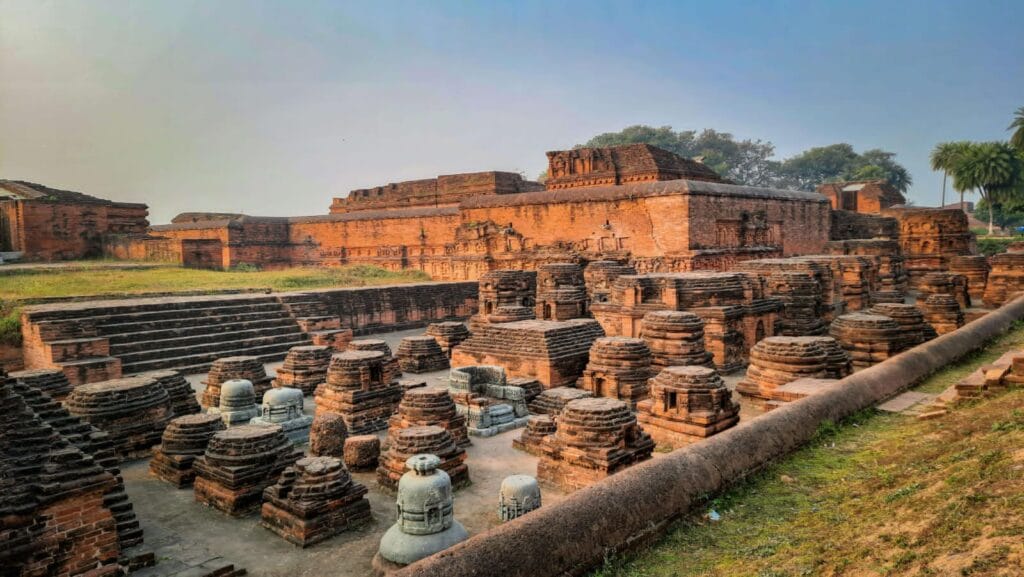Introduction
One of the biggest and most varied educational systems in the world, India’s system has changed dramatically throughout time. Deeply ingrained in the nation’s social, cultural, and historical fabric, its structure has generated some of the most brilliant minds working in a variety of professions around the world. The system still has issues that prevent it from moving forward and becoming more inclusive, despite its successes. In addition to discussing the future, this essay examines the evolution, advantages, and disadvantages of the Indian educational system.
A brief history
The origins of the Indian educational system can be found in the Gurukul system of antiquity, when students lived with their gurus to acquire comprehensive knowledge in a range of subjects, including philosophy, literature, mathematics, and combat. Character development, hands-on learning, and a strong student-teacher bond were prioritized at this time. As time went on, famous educational institutions like Takshashila and Nalanda arose, drawing academics from all over the world. However, a change in emphasis was brought about by the colonial era. To help colonial administration, the British built educational institutions that stressed Western education and produced a workforce that spoke English. A system based on memory, rote learning, and exams resulted from this, and many aspects of the modern educational system still carry on this legacy.

The present education structure of India
Preschool, elementary, secondary, and higher education are the four main tiers of the contemporary Indian educational system. For children ages 6 to 14, free and mandatory education is guaranteed by the Right to Education Act, which was passed in 2009. Focusing on basic courses, primary and secondary education is primarily supervised by state and central boards, including the Central Board of Secondary Education (CBSE) and several state boards. Higher education includes institutions of higher learning that are overseen by organizations such as the All India Council for Technical Education (AICTE) and the University Grants Commission (UGC). Globally competitive professionals are a hallmark of prestigious universities like the All India Institute of Medical Sciences (AIIMS), Indian Institutes of Technology (IITs), and Indian Institutes of Management (IIMs).
The strengths of Indian education system
Strong theoretical underpinnings
In particular, theoretical knowledge is highly valued in the fields of science, technology, engineering, and mathematics (STEM) in the Indian educational system. Many Indians are now highly sought-after worldwide because of their focus, which has prepared them to succeed in various disciplines.
Competitive exams
India’s competitive exam system, which includes the National Eligibility cum Entrance Test (NEET) for medical courses and the Joint Entrance Examination (JEE) for engineering, guarantees that the best candidates are chosen on the basis of merit. Even though these tests are difficult, they have made pupils more resilient and determined.
Diverse heritage
Students in India gain a deep awareness of the nation’s varied heritage through the incorporation of cultural studies into the educational system. Instilling ideals of collaboration and tolerance as well as fostering national unity are facilitated by this.
Focus on technical skills
One of the top exporters of engineers and IT specialists is India. The system’s heavy focus on technical education has produced a skilled labor population that contributes significantly to Silicon Valley and other international tech clusters while also supporting the nation’s economy.
Challanges encountered by Indian Education system
Rote learning
The dependence on rote memorization rather than conceptual understanding and critical thinking is one of the most important critiques leveled at the Indian educational system. Students’ capacity for creativity and problem-solving is restricted by this method, which reduces their adaptability in practical situations.
Unequal access
Even with the Right to Education Act, there are still differences in access to high-quality education, particularly in rural and underdeveloped areas. Many people receive subpar education as a result of inadequate resources, a lack of qualified teachers, and infrastructure flaws
High student-teacher gap
Many schools have an unacceptable student-teacher ratio as a result of the lack of skilled teachers. This disparity affects the standard of instruction and restricts individualized attention, both of which are essential for successful learning.
Mental health
Students are under a lot of pressure to perform well academically due to the fierce competition and emphasis on earning high grades. There is a significant effect on mental health, since stress and worry are growing more prevalent among college and high school students.
Skill gap
Although a lot of graduates are produced by higher education each year, there are frequently concerns about their employability. When industry demands and academic training diverge, the workforce may have theoretical knowledge but lacks practical skills.
The path ahead
The Indian government and educational institutions are attempting to implement reforms in order to address these issues. With its emphasis on a comprehensive and multidisciplinary approach, the National Education Policy (NEP) 2020 represents a dramatic change. By lowering the workload of the curriculum, fostering creativity and critical thinking, and boosting experiential learning, it seeks to revolutionize the educational system. Additionally, the policy aims to improve digital learning and vocational training, which are crucial for preparing students for a global labor market that is constantly evolving. To close the achievement gap between urban and rural schooling, investments in technology integration, infrastructural upgrades, and teacher training programs are also essential. Remote regions are now able to access contemporary educational resources thanks to initiatives like the Digital India campaign and the installation of smart classrooms.

Conclusion
The Indian educational system has produced exceptional scholars and professionals because of its rich history and strong emphasis on academics. Nonetheless, it has issues that need immediate action to guarantee equity, inclusivity, and creativity in education. Realizing the full potential of India’s youth may be possible if a more balanced and comprehensive approach is adopted, as suggested by the NEP 2020. India has the potential to establish itself as a global leader in innovation and education by tackling these issues and producing a new generation of critical thinkers and problem solvers.
☆THANKYOU!☆
- Aarti
- Accident
- Anime
- Astrology
- Bhakti
- Business
- Celebrities
- Chalisa
- Cricket
- Culture
- Discover
- Durga Saptshati
- Economy
- Electronics
- Entertainment
- Exams
- Festival
- Food
- Goverment Scheme
- Health
- Industry
- Lifestyle
- Makeup
- Marketing
- Movies
- News
- Numerology
- Opinion
- PDFs
- Politics
- Puja Vidhi
- Review
- Scholarship Scheme
- Shiv puran
- Skin Care
- Space
- Spiritual
- Sports
- Stocks
- Study
- Sukt
- Summer
- Technology
- Tyohar
- Vishnu puran
- Vrat
- Vrat Katha
- Web Series
- World
- Aarti
- Accident
- Anime
- Astrology
- Bhakti
- Business
- Celebrities
- Chalisa
- Cricket
- Culture
- Discover
- Durga Saptshati
- Economy
- Electronics
- Entertainment
- Exams
- Festival
- Food
- Goverment Scheme
- Health
- Industry
- Lifestyle
- Makeup
- Marketing
- Movies
- News
- Numerology
- Opinion
- PDFs
- Politics
- Puja Vidhi
- Review
- Scholarship Scheme
- Shiv puran
- Skin Care
- Space
- Spiritual
- Sports
- Stocks
- Study
- Sukt
- Summer
- Technology
- Tyohar
- Vishnu puran
- Vrat
- Vrat Katha
- Web Series
- World
- Aarti
- Accident
- Anime
- Astrology
- Bhakti
- Business
- Celebrities
- Chalisa
- Cricket
- Culture
- Discover
- Durga Saptshati
- Economy
- Electronics
- Entertainment
- Exams
- Festival
- Food
- Goverment Scheme
- Health
- Industry
- Lifestyle
- Makeup
- Marketing
- Movies
- News
- Numerology
- Opinion
- PDFs
- Politics
- Puja Vidhi
- Review
- Scholarship Scheme
- Shiv puran
- Skin Care
- Space
- Spiritual
- Sports
- Stocks
- Study
- Sukt
- Summer
- Technology
- Tyohar
- Vishnu puran
- Vrat
- Vrat Katha
- Web Series
- World
- Aarti
- Accident
- Anime
- Astrology
- Bhakti
- Business
- Celebrities
- Chalisa
- Cricket
- Culture
- Discover
- Durga Saptshati
- Economy
- Electronics
- Entertainment
- Exams
- Festival
- Food
- Goverment Scheme
- Health
- Industry
- Lifestyle
- Makeup
- Marketing
- Movies
- News
- Numerology
- Opinion
- PDFs
- Politics
- Puja Vidhi
- Review
- Scholarship Scheme
- Shiv puran
- Skin Care
- Space
- Spiritual
- Sports
- Stocks
- Study
- Sukt
- Summer
- Technology
- Tyohar
- Vishnu puran
- Vrat
- Vrat Katha
- Web Series
- World
- Aarti
- Accident
- Anime
- Astrology
- Bhakti
- Business
- Celebrities
- Chalisa
- Cricket
- Culture
- Discover
- Durga Saptshati
- Economy
- Electronics
- Entertainment
- Exams
- Festival
- Food
- Goverment Scheme
- Health
- Industry
- Lifestyle
- Makeup
- Marketing
- Movies
- News
- Numerology
- Opinion
- PDFs
- Politics
- Puja Vidhi
- Review
- Scholarship Scheme
- Shiv puran
- Skin Care
- Space
- Spiritual
- Sports
- Stocks
- Study
- Sukt
- Summer
- Technology
- Tyohar
- Vishnu puran
- Vrat
- Vrat Katha
- Web Series
- World








